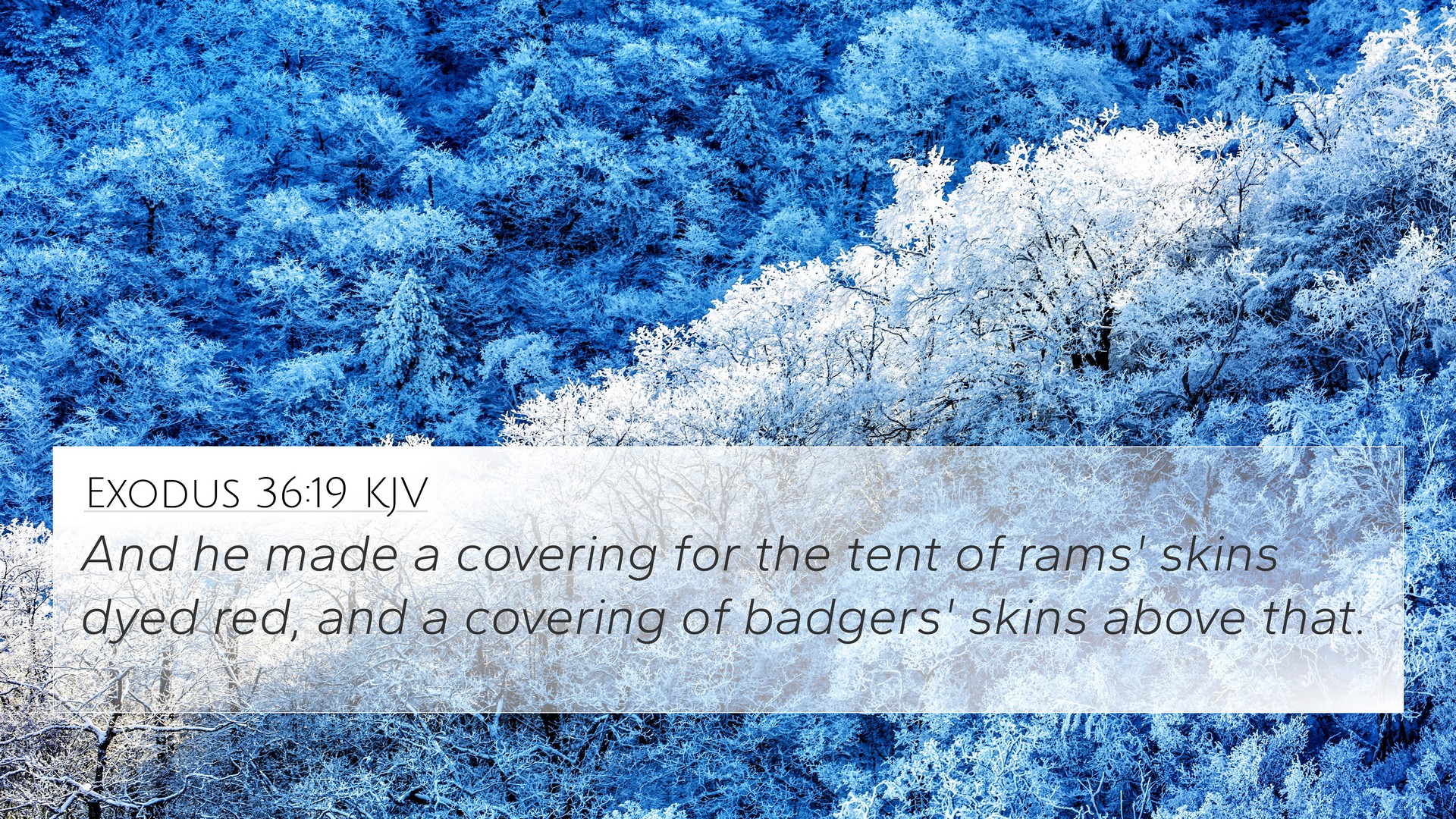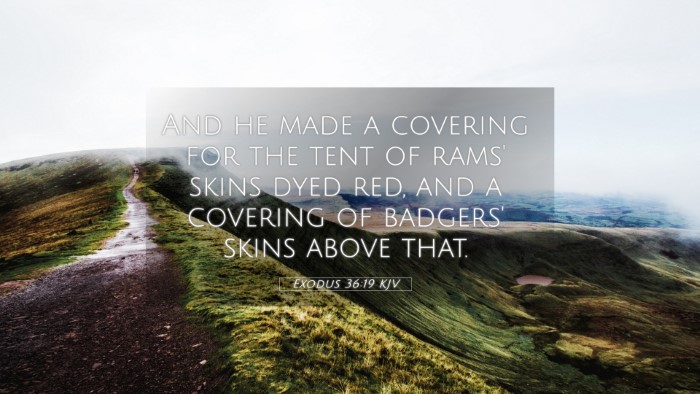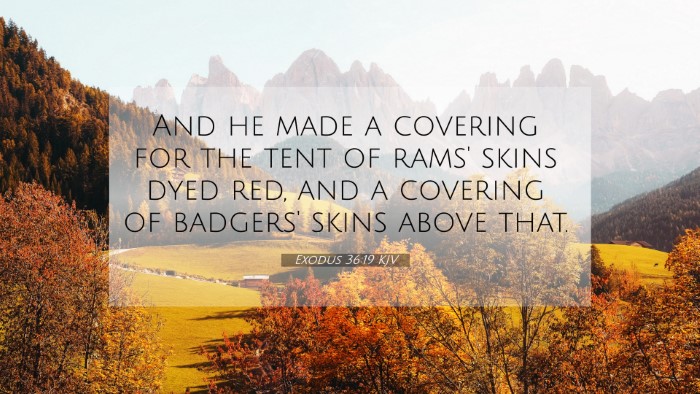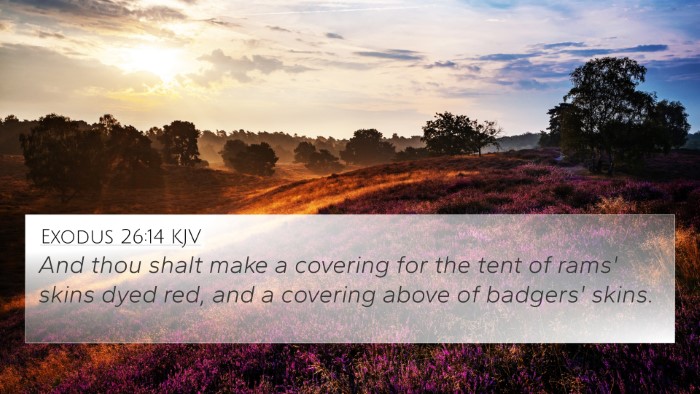Meaning and Interpretation of Exodus 36:19
Exodus 36:19: "And he made a covering for the tent of rams’ skins dyed red, and a covering of badgers’ skins above that."
This verse describes a significant aspect of the construction of the Tabernacle, specifically detailing the materials used for its coverings. The Tabernacle served as a symbol of God's dwelling among His people and was designed with great care and specific instructions.
Insights from Public Domain Commentaries
Matthew Henry’s Commentary
Matthew Henry emphasizes the importance of the materials used in constructing the Tabernacle. The rams' skins, dyed red, symbolize the sacrifice and atonement necessary for communion with God. The badgers' skins, which may protect the inner structures, can represent the idea of protection and holiness within God's presence. Henry suggests that these coverings serve to remind believers of the layers of divine protection and the sacrificial basis of their relationship with God.
Albert Barnes’ Commentary
Albert Barnes notes that the Tabernacle's coverings were not just functional but deeply symbolic. The ram's skin's red dye indicates blood, hinting at the future sacrifice of Christ. Barnes indicates that the badger skins represent protection, as they shield the sacred elements of the Tabernacle from exterior influences. This duality speaks both to the holiness of God and the preparation required to approach Him.
Adam Clarke’s Commentary
Adam Clarke offers a technical examination of the materials, elucidating how these components were vital to the Tabernacle's overall integrity. He draws attention to the rams' skins which, being dyed red, signify a covering of sin through sacrifice. Clarke connects the use of these materials with wider biblical themes of redemption and holiness, indicating that God desires to be both approachable and reverently honored.
Thematic Connections in Scripture
The coverings of the Tabernacle in Exodus 36:19 resonate with numerous themes throughout the Bible. The choice of materials conveys rich theological insights into God's nature and His covenant with humanity.
Cross References
- (Exodus 25:4): Details about the materials used in the construction of the Tabernacle.
- (Leviticus 17:11): The significance of blood and sacrifice in the relationship between God and His people.
- (Hebrews 9:12): Connecting the Old Testament sacrificial system with the ultimate sacrifice of Christ.
- (1 Peter 1:19): The concept of being redeemed with the precious blood of Christ, likening it to the sacrificial nature of the rams' skins.
- (Matthew 27:51): The tearing of the veil in the temple signifies a new access to God, echoing themes of holiness and duality.
- (Isaiah 53:7): The portrayal of the suffering servant, connecting to themes of sacrifice.
- (Revelation 7:14): The image of those washed in the blood of the Lamb, drawing parallels with the sacrificial themes in Exodus.
The Importance of Materials in Biblical Framework
Each material mentioned in this verse holds significance that transcends the physical structure of the Tabernacle. They serve as symbols of deeper theological concepts, such as:
- Protection: The badger skins imply a protective barrier for God's habitation.
- Purity and Sacrifice: The red-dyed rams' skins denote the idea of sacrifice as central to approaching God.
- Holiness: Together, the coverings illustrate the holiness and the set-apart nature of God's dwelling.
Linking Biblical Texts
Through comparative Bible verse analysis, one can find enriching connections between Exodus 36:19 and various New Testament themes. This linkage invites readers to explore:
- How the concept of sacrifice evolved from the Old Testament to the New Testament.
- The representation of Christ as the ultimate covering for humanity’s sin.
- The ongoing theme of God’s presence among His people, as seen in both the Tabernacle and Jesus' promise to never leave us.
Inter-Biblical Dialogue
Exodus 36:19 serves as a pivotal point for understanding the broader narrative of Scripture, linking the sacrificial system illustrated in the Old Testament with the fulfillment found in the New Testament. This inter-Biblical dialogue opens up avenues for deeper study and reflection:
- Engaging with Bible cross-reference guides creates a pathway for understanding how themes of sacrifice are woven throughout the texts.
- The use of tools for Bible cross-referencing can aid in identifying connections between the coverings of the Tabernacle and the spiritual coverings offered through Christ.
- By examining cross-references for sermon preparation, one can illuminate how the continuity of God's story through sacrifice points believers toward a deeper relationship with Him.
Conclusion
In conclusion, Exodus 36:19 encapsulates the beauty of God's dwelling place and illustrates the layers of meaning behind the materials used in its construction. By studying this verse through comprehensive Bible cross-reference materials, believers can enrich their understanding of how the Old Testament prefigures the New Testament's message of redemption, sacrifice, and divine presence in our lives.



